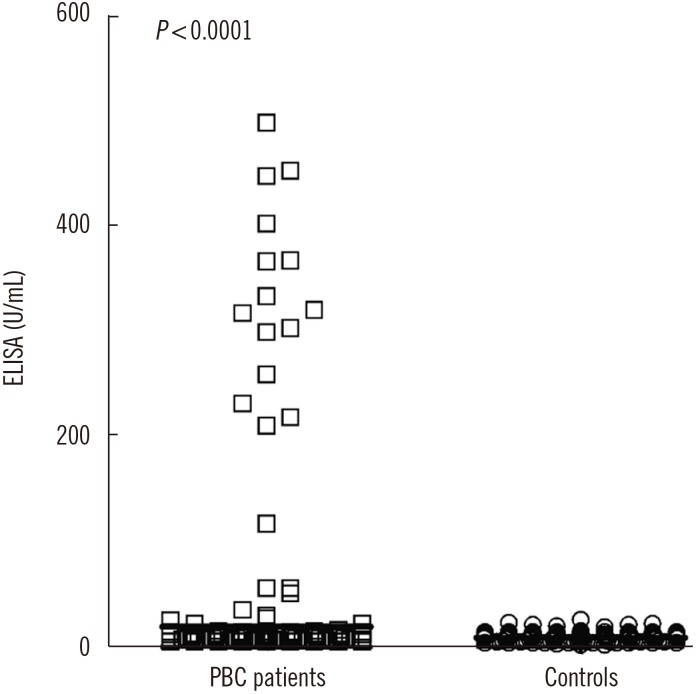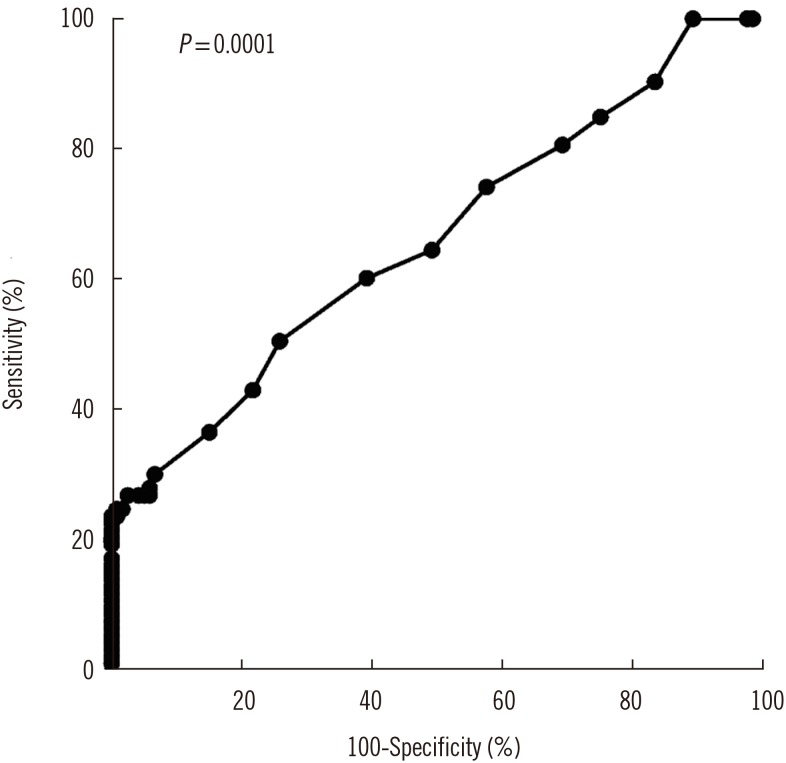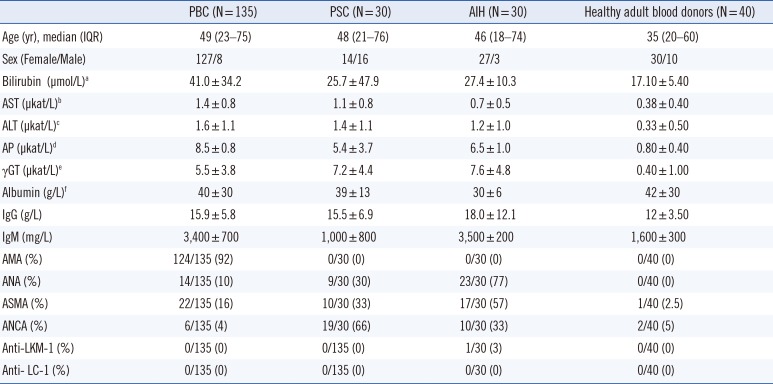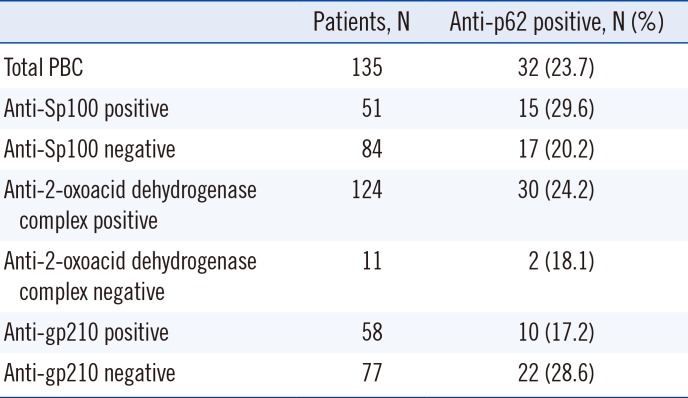1. Carey EJ, Ali AH, Lindor KD. Primary biliary cirrhosis. Lancet. 2015; 386:1565–1575. PMID:
26364546.
2. Invernizzi P, Floreani A, Carbone M, Marzioni M, Craxi A, Muratori L, et al. Primary Biliary Cholangitis: advances in management and treatment of the disease. Dig Liver Dis. 2017; 49:841–846. PMID:
28546061.
3. Kim KA, Ki M, Choi HY, Kim BH, Jang ES, Jeong SH. Population-based epidemiology of primary biliary cirrhosis in South Korea. Aliment Pharmacol Ther. 2016; 43:154–162. PMID:
26526639.
4. Boonstra K, Beuers U, Ponsioen CY. Epidemiology of primary sclerosing cholangitis and primary biliary cirrhosis: a systematic review. J Hepatol. 2012; 56:1181–1188. PMID:
22245904.
5. Terziroli Beretta-Piccoli B, Stirnimann G, Cerny A, Semela D, Hessler R, Helbling B, et al. Geoepidemiology of primary biliary cholangitis: lessons from Switzerland. Clinic Rev Allerg Immunol. 2018; 54:295–306. DOI:
10.1007/s12016-017-8656-x.
6. Ali AH, Carey EJ, Lindor KD. Diagnosis and management of primary biliary cirrhosis. Expert Rev Clin Immunol. 2014; 10:1667–1678. PMID:
25382237.
7. Corrigan M, Hirschfield GM. Aspects of the pathophysiology of primary biliary cirrhosis. Dig Dis. 2015; 33:102–108. PMID:
26641487.
8. Cancado ELR, Harriz M. The importance of autoantibody detection in primary biliary cirrhosis. Front Immunol. 2015; 6:309. PMID:
26157439.
9. Kim KA, Jeong SH. The diagnosis and treatment of primary biliary cirrhosis. Korean J Hepatol. 2011; 17:173–179. PMID:
22102382.
10. Granito A, Muratori P, Quarneti C, Pappas G, Cicola R, Muratori L. Antinuclear antibodies as ancillary markers in primary biliary cirrhosis. Expert Rev Mol Diagn. 2012; 12:65–74. PMID:
22133120.
11. Bogdanos DP, Komorowski L. Disease-specific autoantibodies in primary biliary cirrhosis. Clin Chim Acta. 2011; 412:502–512. PMID:
21185272.
12. Yamagiwa S, Kamimura H, Takamura M, Aoyagi Y. Autoantibodies in primary biliary cirrhosis: recent progress in research on the pathogenetic and clinical significance. World J Gastroenterol. 2014; 20:2606–2612. PMID:
24627596.
13. Bauer A, Habior A, Kraszewska E. Detection of anti-SP100 antibodies in primary biliary cirrhosis. Comparison of ELISA and immunofluorescence. J Immunoassay Immunochem. 2013; 34:346–355. PMID:
23859785.
14. Villalta D, Sorrentino MC, Girolami E, Tampoia M, Alessio MG, Brusca I, et al. Autoantibody profiling of patients with primary biliary cirrhosis using a multiplexed line-blot assay. Clin Chim Acta. 2015; 438:135–138. PMID:
25172039.
15. de Liso F, Matinato C, Ronchi M, Maiavacca R. The diagnostic accuracy of biomarkers for diagnosis of primary biliary cholangitis (PBC) in anti-mitochondrial antibody (AMA)-negative PBC patients: a review of literature. Clin Chem Lab Med. 2017; 56:25–31. PMID:
28731850.
16. Gao L, Tian X, Liu B, Zhang F. The value of antinuclear antibodies in primary biliary cirrhosis. Clin Exp Med. 2008; 8:9–15. PMID:
18385935.
17. Liu H, Norman GL, Shums Z, Worman HJ, Krawitt EL, Bizzaro N, et al. PBC screen: an IgG/IgA dual isotype ELISA detecting multiple mitochondrial and nuclear autoantibodies specific for primary biliary cirrhosis. J Autoimmun. 2010; 35:436–442. PMID:
20932720.
18. Invernizzi P, Selmi C, Ranftler C, Podda M, Wesierska-Gadek J. Antinuclear antibodies in primary biliary cirrhosis. Semin Liver Dis. 2005; 25:298–310. PMID:
16143945.
19. Tsangaridou E, Polioudaki H, Sfakianaki R, Samiotaki M, Tzardi M, Koulentaki M, et al. Differential detection of nuclear envelope autoantibodies in primary biliary cirrhosis using routine and alternative methods. BMC Gastroenterol. 2010; 10:28. PMID:
20205958.
20. Bauer A, Habior A. Measurement of gp210 autoantibodies in sera of patients with primary biliary cirrhosis. J Clin Lab Anal. 2007; 21:227–231. PMID:
17621358.
21. Sasaki M, Miyakoshi M, Sato Y, Nakanuma Y. A possible involvement of p62/sequestosome-1 in the process of biliary epithelial autophagy and senescence in primary biliary cirrhosis. Liver Int. 2012; 32:487–499. PMID:
22098537.
22. Chantran Y, Ballot E, Johanet C. Autoantibodies in primary biliary cirrhosis: antinuclear envelope autoantibodies. Clin Res Hepatol Gastroenterol. 2014; 38:256–258. PMID:
24268998.
23. Hu CJ, Zhang FC, Li YZ, Zhang X. Primary biliary cirrhosis: what do autoantibodies tell us? World J Gastroenterol. 2010; 16:3616–3629. PMID:
20677333.
24. European Association for the Study of the Liver. EASL Clinical Practice Guidelines: management of cholestatic liver diseases. J Hepatol. 2009; 51:237–267. PMID:
19501929.
25. Alvarez F, Berg PA, Bianchi FB, Bianchi L, Burroughs AK, Cancado EL, et al. International Autoimmune Hepatitis Group Report. International Autoimmune Hepatitis Group Report: review of criteria for diagnosis of autoimmune hepatitis. J Hepatol. 1999; 31:929–938. PMID:
10580593.
26. Muratori P, Muratori L, Ferrari R, Cassani F, Bianchi G, Lenzi M, et al. Characterization and clinical impact of antinuclear antibodies in primary biliary cirrhosis. Am J Gastroenterol. 2003; 98:431–437. PMID:
12591064.
27. Wesierska-Gadek J, Hohenuer H, Hitchman E, Penner E. Autoantibodies against nucleoporin p62 constitute a novel marker of primary biliary cirrhosis. Gastroenterology. 1996; 110:840–847. PMID:
8608894.
28. Miyachi K, Shibata M, Onozuka Y, Kikuchi F, Imai N, Horigome T. Primary biliary cirrhosis sera recognize not only gp210 but also proteins of the p62 complex bearing N-acetylglucosamine residues from rat liver nuclear envelope. Anti-p62 complex antibody in PBC. Mol Biol Rep. 1996; 23:227–234. PMID:
9112233.
29. Wesierska-Gadek J, Klima A, Komina O, Ranftler C, Invernizzi P, Penner E. Characterization of autoantibodies against components of the nuclear pore complexes: high frequency of anti-p62 nucleoporin antibodies. Ann N Y Acad Sci. 2007; 1109:519–530. PMID:
17785341.
30. Wesierska-Gadek J, Klima A, Ranftler C, Komina O, Hanover J, Invernizzi P, et al. Characterization of the antibodies to p62 nucleoporin in primary biliary cirrhosis using human recombinant antigen. J Cell Biochem. 2008; 104:27–37. PMID:
17960595.
31. Invernizzi P, Podda M, Battezzati PM, Crosignani A, Zuin M, Hitchman E, et al. Autoantibodies against nuclear pore complexes are associated with more active and severe liver disease in primary biliary cirrhosis. J Hepatol. 2001; 34:366–372. PMID:
11322196.
32. Lammers WJ, Van Buuren HR, Hirschfield GM, Janssen HLA, Invernizzi P, Mason AL, et al. Levels of alkaline phosphatase and bilirubin are surrogate end points of outcomes of patients with primary biliary cirrhosis: an international follow-up study. Gastroenterology. 2014; 147:1338–1349.e5. quiz e15. PMID:
25160979.
33. Murillo Perez CF, Gulamhusein A, van Buuren HR, Lammers WJ, Goet JC, Ponsioen CY, et al. Bilirubin is predictive of transplant-free survival even within the normal range in primary biliary cholangitis patients. Hepatology. 2017; 66:41A–42A.
34. Wesierska-Gadek J, Penner E, Battezzati PM, Selmi C, Zuin M, Hitchman E, et al. Correlation of initial autoantibody profile and clinical outcome in primary biliary cirrhosis. Hepatology. 2006; 43:1135–1144. PMID:
16628641.
35. Gatselis NK, Zachou K, Norman GL, Gabeta S, Papamichalis P, Koukoulis GK, et al. Clinical significance of the fluctuation of primary biliary cirrhosis-related autoantibodies during the course of the disease. Autoimmunity. 2013; 46:471–479. PMID:
23777462.









 PDF
PDF ePub
ePub Citation
Citation Print
Print



 XML Download
XML Download